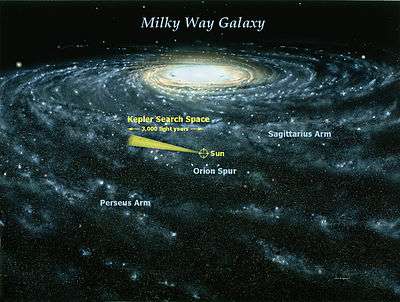EChO
The Exoplanet Characterisation Observatory (EChO) was a proposed space telescope[2] as part of the Cosmic Vision roadmap of the European Space Agency, and competed with four other missions for the M3 slot in the programme. On 19 February 2014 the PLATO mission was selected in place of the other candidates in the programme, including EChO.[4]
| Mission type | Astronomy |
|---|---|
| Operator | ESA |
| Website | sci.esa.int/echo |
| Mission duration | 4–5 years[1][2] |
| Spacecraft properties | |
| Launch mass | 2,100 kg (4,600 lb)[3] |
| Start of mission | |
| Launch date | 2024[1] |
| Rocket | Soyuz STA/Fregat[2] |
| Launch site | Kourou ELS[3] |
| Contractor | Arianespace |
| Orbital parameters | |
| Reference system | Sun–Earth L2[2][3] |
| Regime | Halo or Lissajous |
| Epoch | planned |
| Main telescope | |
| Type | Cassegrain[2] |
| Diameter | 1.4 m (4.6 ft)[2] |
| Focal length | 2 m (6.6 ft)[2] |
| Collecting area | 14 m2 (150 sq ft)[2] |
| Wavelengths | from 0.55 µm (orange) to 11µm (long-infrared) (goal: 0.4 to 16 µm)[1][2] |
EChO would have been the first dedicated mission to investigate exoplanetary atmospheres, addressing the suitability of those planets for life and placing the Solar System in context. EChO was intended to provide high resolution, multi-wavelength spectroscopic observations. It would have measured the atmospheric composition, temperature and albedo of a representative sample of known exoplanets, constrain models of their internal structure and improve our understanding of how planets form and evolve.[5] It would have orbited around the L2 Lagrange point, 1.5 million km from Earth in the anti-sunward direction.
SPEChO
Following PLATO's M3 selection, a proposal to add EChO on the joint Japanese-European SPICA far-infrared telescope emerged.[6] The proposed EChO instrument on SPICA (SPEChO) is a spectrometer covering light wavelengths from 5 to 20 micrometres, and will observe exoplanet atmospheres utilizing transit spectroscopy.[6][7] As long with a potential to recover the original scientific goals from EChO, SPEChO will enable SPICA to conduct specialized exoplanetary science studies. SPEChO may also be useful for the science case of galaxies.[8] However SPEChO's capabilities overlap with the James Webb Space Telescope's MIRI (Mid-Infrared Instrument), therefore SPEChO's advantages over other instruments has become a focus of whether or not to include it on SPICA.[6][9]
Other M3 mission candidates
References
- "EChO mission summary". EChO website. ESA. 16 December 2013. Retrieved 28 January 2014.
- Tinetti, G.; Beaulieu, J. P.; Henning, T.; Meyer, M.; Micela, G.; Ribas, I.; Stam, D.; Swain, M.; Krause, O.; Ollivier, M.; Pace, E.; Swinyard, B.; Aylward, A.; Boekel, R.; Coradini, A.; Encrenaz, T.; Snellen, I.; Zapatero-Osorio, M. R.; Bouwman, J.; Cho, J. Y. K.; Coudé De Foresto, V.; Guillot, T.; Lopez-Morales, M.; Mueller-Wodarg, I.; Palle, E.; Selsis, F.; Sozzetti, A.; Ade, P. A. R.; Achilleos, N.; et al. (2012). "EChO - Exoplanet Characterisation Observatory" (PDF). Experimental Astronomy. 34 (2): 311. arXiv:1112.2728. Bibcode:2012ExA....34..311T. doi:10.1007/s10686-012-9303-4.
- "EChO spacecraft". EChO website. ESA. 30 June 2013. Retrieved 28 January 2014.
- "ESA selects planet-hunting PLATO mission". ESA. 19 February 2014. Retrieved 20 March 2014.
- Tinetti, G.; Cho, J. Y. K.; Griffith, C. A.; Grasset, O.; Grenfell, L.; Guillot, T.; Koskinen, T. T.; Moses, J. I.; Pinfield, D.; Tennyson, J.; Tessenyi, M.; Wordsworth, R.; Aylward, A.; Van Boekel, R.; Coradini, A.; Encrenaz, T.; Snellen, I.; Zapatero-Osorio, M. R.; Bouwman, J.; Du Foresto, V. C.; Lopez-Morales, M.; Mueller-Wodarg, I.; Pallé, E.; Selsis, F.; Sozzetti, A.; Beaulieu, J. P.; Henning, T.; Meyer, M.; Micela, G.; et al. (2011). "The science of EChO" (PDF). Proceedings of the International Astronomical Union. 6: 359–370. Bibcode:2011IAUS..276..359T. doi:10.1017/S1743921311020448.
- "SPICA計画の経緯・現状" (PDF) (in Japanese). Japan Radio Astronomy Forum. 28 January 2015. Retrieved 2017-01-03.
- "SPICAの現状" (PDF). Institute for the Physics and Mathematics of the Universe. 5 June 2015. Retrieved 2017-01-03.
- "SPICAサイエンス検討中間報告" (PDF) (in Japanese). Group of Optical and Infrared Astronomers SPICA task force. 26 November 2014. Retrieved 2017-01-03.
- "タスクフォースからの提言 近傍銀河および星惑星系形成分野" (PDF) (in Japanese). Group of Optical and Infrared Astronomers SPICA task force. 26 November 2014. Retrieved 2017-01-03.

